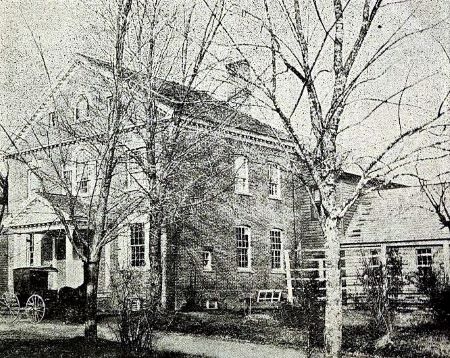
Two months before the rapid-spreading COVID-19 virus was declared a global pandemic, a Princess Anne consignment shop added a charcoal drawing of a local 18th-century home to its eclectic inventory.
Somerset Choice manager Sharon Upton recognized the work of art might have special meaning to the University of Maryland Eastern Shore – and alerted the historically Black institution.
“I thought it belonged on the campus,” said Upton, a retired educator and volunteer with the Somerset County Historical Society, which operates the shop as a revenue source in a renovated gasoline filling station.
The drawing is of a 2½-story dwelling featuring Flemish bond brickwork and a distinctive Palladian window that became UMES’ first building. The Federal-style structure stood several paces behind the north wing of John T. Williams Hall, the university’s administration building since 1940.
Ezekiel Haynie of Northumberland County, Va., a surgeon in the Continental army who set up a medical practice in Snow Hill, had “Olney” built and moved there in 1798. He died the following year and over the ensuing eight decades the home fell into disrepair. It eventually was purchased for $2,000 in 1886 by the Methodist Episcopal Church.
The denomination emerged in post-Reconstruction America as a leader educating Blacks in hopes of providing a path to a more productive life.
Olney was described by a church elder involved in the property transaction as a “place of sixteen acres, with a large but deserted mansion and some other buildings on it.” After undergoing a hasty renovation, Delaware Conference Academy opened Sept. 13, 1886 as a prep-school branch of Baltimore’s Morgan College.
Subsequent images of the mansion-turned-schoolhouse appeared in books and college catalogs, so the drawing at the consignment shop likely was inspired by those photos and illustrations.
What makes the work of art compelling to UMES, however, is the artist.
Doris Maslin Cohn, a daughter of a prominent Winston-Salem, N.C. banker, married Edward Herrman Cohn in 1916 and relocated to Princess Anne, where her husband was a second-generation businessman operating a feed and lumber business.
Doris Cohn was described in her December 1973 obituary as an artist of some renown who found inspiration in historic dwellings, of which Somerset County has many. Her works occasionally were featured in one-woman shows along the East Coast, according to the obituary.
More importantly, she was the three-time great-granddaughter of Dr. Ezekiel Haynie, the man who commissioned Olney.
No provenance – or historical background – accompanied the consignment shop drawing, which was mounted in a rough-hewn wooden frame embellished with dentil molding. Cohn did sign and label it “Olney,” but did not date the drawing.

As the pandemic began to recede in the spring of 2022, the university sought Michel Demanche’s advice on stabilizing the artwork acquired from the consignment shop.
Demanche, a retired UMES fine arts professor and president of the Somerset County Arts Council, remembered thinking, “wow, this thing needs some help.”
“I could see it was an original drawing that deserved the help,” she said.
The arts council opened an unassuming frame shop in Crisfield in 2021 “to help community members with their ability to preserve” heirlooms and keepsakes, Demanche said.
Demanche recognized the importance of Cohn’s drawing and accepted the challenge. The preservation, she said, took four days, which included separating the drawing from a failing matte board to which it had been affixed with a petrified liquid adhesive.
The fragile paper endured some minor tearing, but Demanche stabilized it with rice paper. Using acid-free glue, she remounted the drawing on archival-quality matting, cleaned the original glass, then sanded and rubbed the original frame with a gold-tinted acrylic stain.
“I wanted to do everything I could to preserve the look it had when it was originally framed,” Demanche said.
Sadly, Olney became irreparably unsound and was demolished in the spring of 1969.
The University of Maryland Eastern Shore expresses its appreciation to the Somerset County Historical Society and the Somerset County Arts Council in helping add an important piece of history to the institution’s archive collection.

